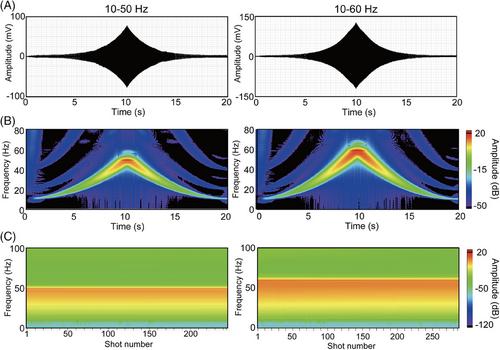Takeshi Tsuji, Eiichi Arakawa, Hitoshi Tsukahara, Fumitoshi Murakami, Naoshi Aoki, Susumu Abe, Takuya Miura
下载PDF
{"title":"Signal propagation from portable active seismic source (PASS) to km-scale borehole DAS for continuous monitoring of CO2 storage site","authors":"Takeshi Tsuji, Eiichi Arakawa, Hitoshi Tsukahara, Fumitoshi Murakami, Naoshi Aoki, Susumu Abe, Takuya Miura","doi":"10.1002/ghg.2249","DOIUrl":null,"url":null,"abstract":"<p>We have developed a portable active seismic source (PASS) to monitor CO<sub>2</sub> storage reservoirs at a depth of approximately 1 km. Despite its small size, stacking the signals generated by the PASS improves the signal-to-noise ratio of the seismometer data far from the source. The smaller size and lower cost of the PASS enables its permanent deployment in many locations to continuously monitor CO<sub>2</sub> storage reservoirs. To achieve continuous monitoring, distributed acoustic sensing (DAS) is also a vital technology. Based on DAS, we can continuously record the signal from the PASS in an extensive area, including within boreholes and offshore fields. Here we report application of the PASS for the borehole DAS system. We confirmed the PASS signal propagation to a depth of ∼1 km when we used a PASS with 630N at 50 Hz close to the wellhead and recorded the signal by the borehole fiber optic cable. The ability of the system to propagate the PASS signal to a depth of ∼1 km enables continuous monitoring of most CO<sub>2</sub> storage reservoirs with high temporal resolution. Furthermore, deploying multiple PASS systems could improve the spatial resolution of monitoring results. © 2023 Society of Chemical Industry and John Wiley & Sons, Ltd.</p>","PeriodicalId":12796,"journal":{"name":"Greenhouse Gases: Science and Technology","volume":"14 1","pages":"4-10"},"PeriodicalIF":2.8000,"publicationDate":"2023-12-04","publicationTypes":"Journal Article","fieldsOfStudy":null,"isOpenAccess":false,"openAccessPdf":"https://onlinelibrary.wiley.com/doi/epdf/10.1002/ghg.2249","citationCount":"0","resultStr":null,"platform":"Semanticscholar","paperid":null,"PeriodicalName":"Greenhouse Gases: Science and Technology","FirstCategoryId":"93","ListUrlMain":"https://scijournals.onlinelibrary.wiley.com/doi/10.1002/ghg.2249","RegionNum":4,"RegionCategory":"环境科学与生态学","ArticlePicture":[],"TitleCN":null,"AbstractTextCN":null,"PMCID":null,"EPubDate":"","PubModel":"","JCR":"Q3","JCRName":"ENERGY & FUELS","Score":null,"Total":0}
引用次数: 0
引用
批量引用
Abstract
We have developed a portable active seismic source (PASS) to monitor CO2 storage reservoirs at a depth of approximately 1 km. Despite its small size, stacking the signals generated by the PASS improves the signal-to-noise ratio of the seismometer data far from the source. The smaller size and lower cost of the PASS enables its permanent deployment in many locations to continuously monitor CO2 storage reservoirs. To achieve continuous monitoring, distributed acoustic sensing (DAS) is also a vital technology. Based on DAS, we can continuously record the signal from the PASS in an extensive area, including within boreholes and offshore fields. Here we report application of the PASS for the borehole DAS system. We confirmed the PASS signal propagation to a depth of ∼1 km when we used a PASS with 630N at 50 Hz close to the wellhead and recorded the signal by the borehole fiber optic cable. The ability of the system to propagate the PASS signal to a depth of ∼1 km enables continuous monitoring of most CO2 storage reservoirs with high temporal resolution. Furthermore, deploying multiple PASS systems could improve the spatial resolution of monitoring results. © 2023 Society of Chemical Industry and John Wiley & Sons, Ltd.
从便携式有源地震源(PASS)到千米级井眼DAS的信号传播,用于连续监测CO2储存地点
我们开发了一种便携式活动地震源(PASS),用于监测深度约1公里的二氧化碳储层。尽管它的体积很小,但叠加由PASS产生的信号可以提高远离震源的地震仪数据的信噪比。由于PASS的体积更小,成本更低,因此可以在许多地方永久部署,持续监测二氧化碳储存库。为了实现连续监测,分布式声传感(DAS)也是一项至关重要的技术。基于DAS,我们可以在大范围内连续记录来自PASS的信号,包括井眼内和海上油田。本文报道了PASS在井下DAS系统中的应用。当我们在井口附近使用630N, 50 Hz的PASS时,我们确认了PASS信号的传播深度为1公里,并通过钻孔光纤电缆记录了信号。该系统能够将PASS信号传播到~ 1公里的深度,从而能够以高时间分辨率连续监测大多数二氧化碳储存库。此外,部署多个PASS系统可以提高监测结果的空间分辨率。©2023化学工业协会和John Wiley &儿子,有限公司
本文章由计算机程序翻译,如有差异,请以英文原文为准。



 求助内容:
求助内容: 应助结果提醒方式:
应助结果提醒方式:


